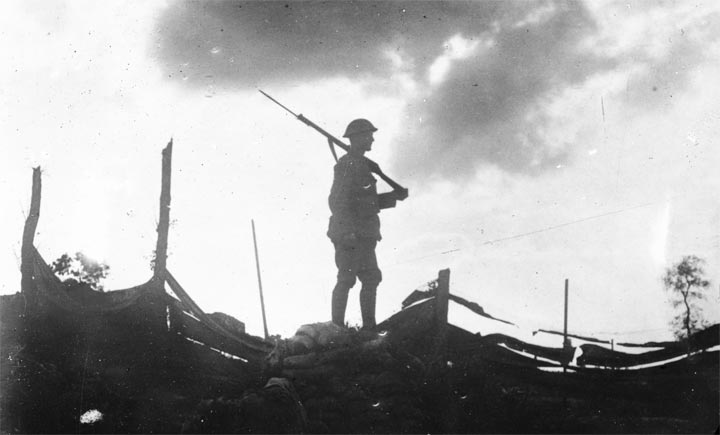MB367/148966, Victoria League of New Zealand Records, A lone Australian sentry keeps watch (Lt. Ernest Brooks; Fleurbaix, France; June 1916).

A lone Australian sentry keeps watch

MB367/148966, Victoria League of New Zealand Records, A lone Australian sentry keeps watch (Lt. Ernest Brooks; Fleurbaix, France; June 1916).
Due to an obvious interest from those at home to connect with those at the front during the war, British propagandists needed ways of depicting soldiers at the front to those at home.
This photograph, by Lt. Ernest Brooks, a British official war photographer, depicts an unidentified Australian sentry in Fleurbaix, France, in June 1916, presumably in the lead up to the Battle of Fromelles. This battle was a joint Australian and British operation, to divert German forces from the Somme offensive of 1916. Resultant Australian losses were high, over 5,500, to Britain and Germany’s 1,500 each. This photograph is typical of Brooks’ work, specifically his use of silhouette, and also reflects the practical concerns of official photographers during the war. Such images were popular not only due to their ease of reproduction in the press, which Brooks, as a former Daily Mirror photographer, was aware of, but also for their strong emotional, and propaganda worth. This image is a clear indication of the awareness of official war photographers of the emotional and artistic impact of their images, and their attempts to create evocative photographs in their own right, rather than simply as a document of the war. Photographs such as these allowed a public desperate for news from the front to experience warfare in a way that had been impossible before the First World War. As such, the image is an effective depiction of the duties of sentries keeping watch, amidst the devastation of the war. However, dramatic silhouette images went beyond this, as they also facilitated a strong symbolic emotional connection between home and the front. The obscuring of the sentry’s identity meant that he became a symbol of all soldiers at the front, as he could have been anyone’s brother, son, husband or sweetheart, thus reducing a nations' war effort to a single image of heroism, echoing the symbol of the Unknown Soldier. As such, silhouette images of war were extremely popular in the domestic British press during the war.